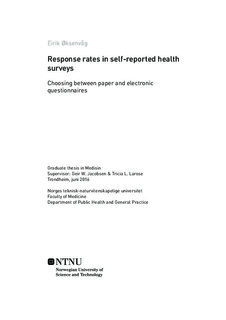| dc.description.abstract | Background: Health surveys are a useful tool for collection of information that is not readily available from other sources. However, response rates have steadily declined in recent years, increasing the risk of selection bias. Computer and software technology allows for more efficient data collection, and may increase response rates, particularly with younger adults. Methods: Paper questionnaires were sent out to 964 mothers and 593 offspring who consented to further follow-up as part of the Scandinavian Successive Small-for-Gestational Age follow-up, Trondheim, Norway 2013-2015. In a nested case-control survey, n= 122 randomly selected mothers and n=129 randomly selected offspring had the option to choose between response modes; paper or electronic questionnaire. Response rates were calculated and selected baseline characteristics of responders were compared. Results: Response rates dropped 10 percentage points among mothers and 18 percentage points among offspring when they were given the option to choose between paper and electronic response modes. Socio-demographic, lifestyle and health characteristics of mixed mode responders were not significantly different from controls. Conclusions: When conducting health surveys in large cohort populations it is preferable to employ one mode of response rather than several. Further research is required to determine whether electronic surveys are preferable to paper surveys. | nb_NO |
